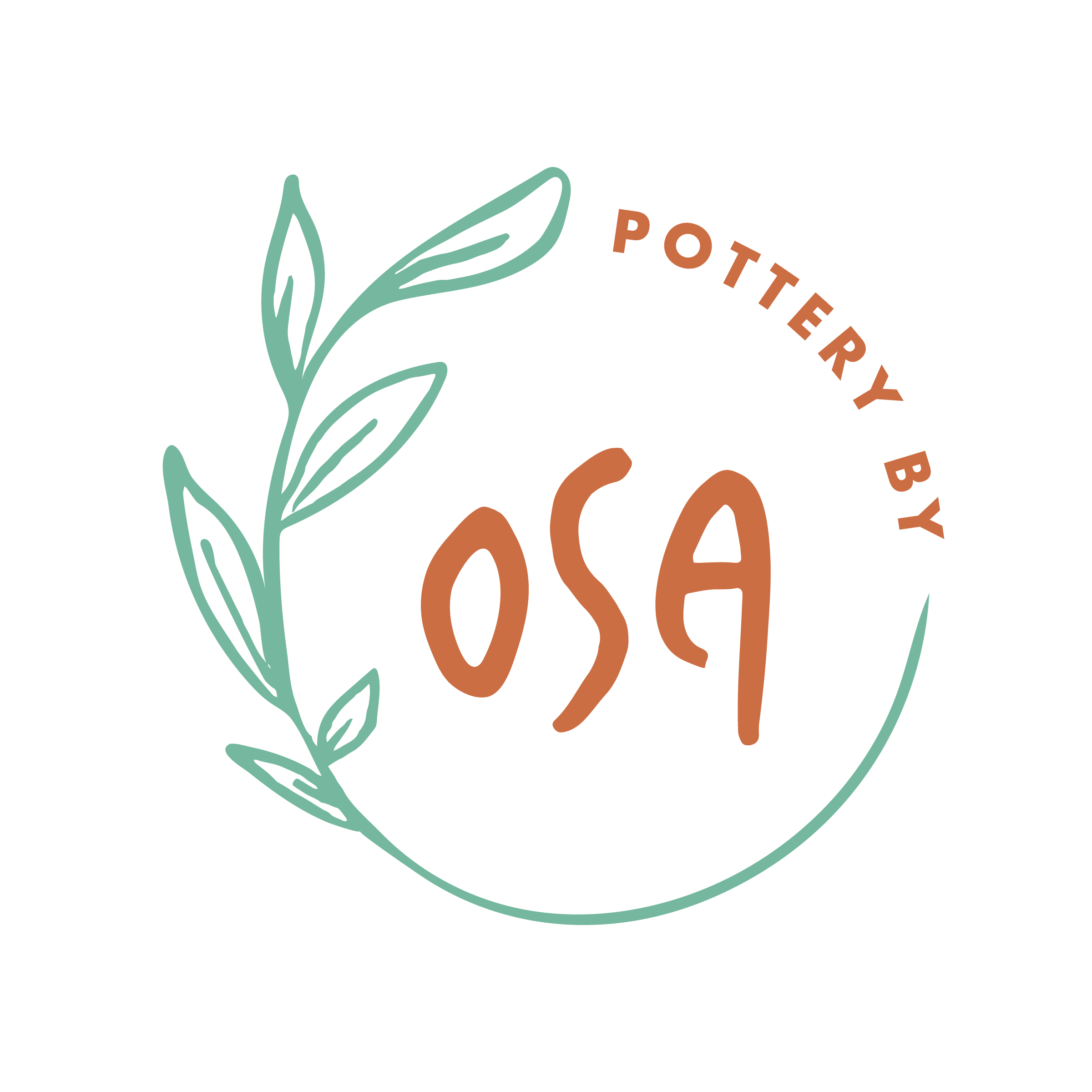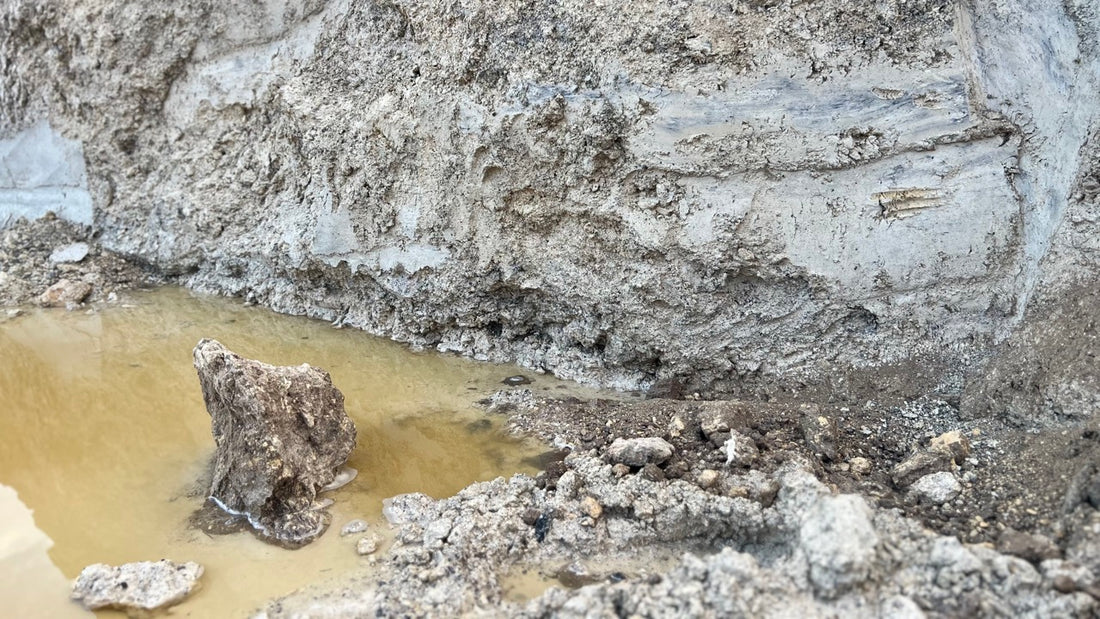
What I'd like to share is a non-technical approach to wild clay: being led by openness and curiosity, trusting our observations and intuition, and embracing unexpected outcomes. I work with wild clay to feel more deeply connected to the earth and to bear witness to those small, quiet miracles in nature. I hope that more people feel inspired to do the same without feeling intimidated by "not knowing anything" about wild clay.
Everything I've learned about wild clay came from experimentation, talking to other potters and doing my own research. Many potters who work with wild clay amend it with mined materials to create clay bodies that vitrify at specific temperatures or that work best for their process (wheel throwing, hand building, sculpture, etc.) Others blend different wild clays and other foraged materials, as I ended up doing, to achieve desired results. (The bowl above was coil built using wild clay and fired with sawdust inside a saggar in an outdoor wood burning rocket kiln. I will discuss firing methods at a later time.)
Ultimately, I am interested in what natural, unamended clay can do on its own and I'm curious about its qualities, straight from the ground.
When I work with clay in this way, it feels like a collaboration instead of an exercise in controlling the material. I have to yield to the clay. I have to change my approach to suit it. That being said, most clays needs to be processed and adjusted in some way, however minimally. Working with foraged clay from a single site activates my curiosity about ancient ceramic processes. Most of the pre-Columbian pottery shards found here in Florida show that the clay used was tempered with ground shells, sand, even plant fiber. There is an online database from the Florida Museum of Natural History of different indigenous pottery types that documents some of this information. The clay I'm using was collected in former Calusa territory, about a half mile from the Myakka River.

Below, are responses to a few of the questions sent to me from Instagram followers. I won't be addressing basic technical questions that are already answered elsewhere on the Internet. Instead I responded to questions that are particular to my experience, specifically working with my current batch of Florida wild clay from Sarasota County. That means that some of my answers may not apply to the other wild clays I've collected from other areas or to the clay you may have found in another part of the country. It is important to understand that all natural clays are different and there is no one-size-fits-all way of working with them.
Q: How has the change from working with commercial clay to working with wild clay surprised you?
The clay I'm using is surprisingly forgiving and easy to work with. It remoistens easily, it doesn't crack, it's easy to mold but keeps its shape and, so far, it seems more resistant to thermal shock than the commercial clays I've used. I still experience this ease, even though it is not suitable for carving (my go-to surface decoration technique) because of its texture. Instead, I pivoted to decorating my surfaces with coils, a technique inspired by Ibo pottery from Nigeria. This is an example of a collaboration with clay. In a sense, I let the clay tell me how it should be used. I think that is where that feeling of high inspiration comes from when I make these pots.
The entire testing process was a surprise. In its raw form, the clay I'm working with is dark gray and very plastic (left photo below). When fired to cone 6, it takes on the look and feel of a tortilla chip, transforming to a pale yellow color with a granulated surface. When you're working with commercial clay, there is no surprise at all. You request a red stoneware clay that fires to cone 6 and that's exactly what you get. In its unamended, natural state, this wild clay is also prone to cracking, as you can see from the photo on the right. (The solution to this issue was also a huge surprised, addressed in my next answer.) The other unexpected quality of this clay will probably be more interesting to other ceramicists than to the lay person: the clay is like bisqueware (i.e. light and extremely porous) at cone 6 (over 2200°F) but begins to melt at cone 7. It turns into a puddle of glaze at cone 8.

Q: Do you end up adding anything to the wild clay to make it more useable?
I was extremely impressed with the plasticity and strength of the gray wild clay straight from the ground. I already knew I wanted to coil build with it, so I did not think about how to make it more suitable for wheel throwing (although, I have a feeling it would work just fine on the wheel.) My issue, as I mentioned in the last section, was the cracking. No matter how much I compressed the bottom of the pot, a tiny crack would appear when I fired it. I tried adding sand, which is a common remedy for cracking, but it didn't work.
While I was thinking it over, my husband and I decided to visit the site where the clay came from to see it, pay respect to the land and collect more clay. I expected to find the same plastic, gray stuff but instead ended up finding three additional clay types! The first two below on the left have low plasticity. They dry quickly, crumble easily and leave a soft, powdery residue on your fingers which is a telltale characteristic of kaolin. I had read about other ceramicists who use wild clay combining two different types of clay to create a nice, workable clay body, so I tried it.

I combined the new kaolinitic clay with the gray clay and it worked! Together, they create a clay body better than either of its components used separately.
By combining these two different clays in roughly equal amounts, the issue of cracking was resolved. These kinds of moments in life blow me away. No amount of research or testing would have led me to a better, more pleasant solution, although I did end up learning more about primary and secondary clays through this process.
So, that is how I settled on the clay body I've been using to make work: I combine the two clays below on the right and then wedge in some sand from Sarasota Bay because I like the look of the inclusions in the clay (adding sand had no effect on the cracking). The sample below on the far right shows my final clay body with all three combined ingredients.

Q: Spiritually or on a non-rational level, how different do you feel working with this clay?
I think of the phrase high vibrational. The difference between commercial clay and wild clay is the difference between greens in a plastic bag from the store and greens harvested from your own garden, the difference between water gushing from an underground spring and the city water that comes out of your tap. I don't want to create a false dichotomy of better or worse here; those of us who have easy access to grocery stores and running water are extremely lucky. But I do think we can all agree that, especially in industrialized parts of the world, we have become alienated from nature. Before, when I walked through the woods, I would notice the plants and animals, but I never thought twice about the ground under my feet. Now, I do.
Creating this body of work, using the coil building techniques taught to me by Jabulile Nala and this local foraged clay, I felt absolutely inspired and energized, like I needed to make those pots. There is simply a deeper connection with the work after collecting, testing, processing and finally making. I feel an even deeper sense of gratitude for all things, including clay and there is the eerie feeling that I'm supposed to be making this work. There is also some humility, considering the thousands of years it took for that clay to form underground. Anything that old must contain wisdom and since I'm starting down this path, I expect the lessons to continue to unfold over time.
Thank you to Richard Munster, Mitch Iburg, Studio Alluvium and Lisa Orr for your helpful thoughts and suggestions. Thank you to my husband, Joey O'Mahoney, for being with me every step of the way from clay collecting to kiln building. I'd also like to thank Robin Wall Kimmerer for her book Braiding Sweetgrass which has taught me to be a better collaborator with nature and to respect the personhood of all things, animate or inanimate.


1 comment
Hi Osa,
I just wanted to thank you for taking the time to describe your adventures with natural clay and how it has taught you the joy of connecting to the earth. It is truly inspiring!
I have been admiring your work from afar since I first heard of you, and I hope to one day have a piece of it. Here is something you taught me: I have always loved pottery, and I don’t know another single soul who loves it like I do. So I signed up for and took a couple of wheel throwing classes, which I thoroughly enjoyed despite having no particular talent. One thing I kept doing (probably true for many learners) was leaving too much clay in the bowl or vase, with walls too thick to be considered elegant. It occurred to me then (some 30 years ago) that I could use that to “carve” on the surface, but I dismissed the idea as a cover for clumsiness. So wonderful that you trusted your own creative muse, and I intend to do the same in any future endeavors.
Bless you,
Lisa